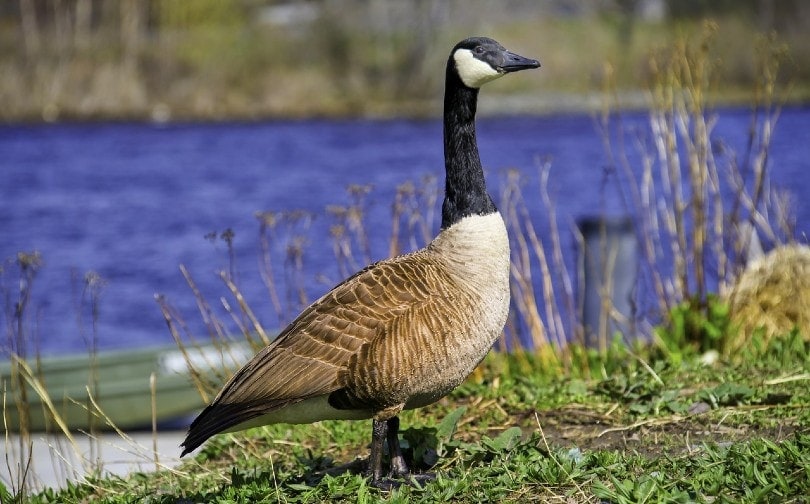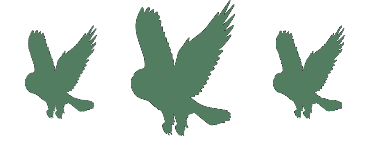15 Interesting & Fun Canada Goose Facts
Last Updated on

If you lived in North America or have visited, there’s a chance that you have seen the Canada Goose.
These large geese have also made a name for themselves on social media. They’re well-known for their aggressive yet hilarious attacks on hapless people who cross the wrong goose’s path.
Canada Geese are amazing, so if you’re here to learn more about these beautiful and sometimes scary birds, we have 15 facts that will hopefully be of interest to you.

15 Canada Goose Facts
1. Canada Geese Are Native to North America
Canada Geese are native to North America. They do most of their breeding in Canada but start to move south to continue breeding throughout the winter. This is when they are found primarily in the U.S. and Mexico, where they do their wintering.
However, they have been introduced to other parts of the world and can be seen around Europe, Russia, and even Iceland.

2. Canada Geese Form a “V” When Flying South
Typically, Canada Geese fly south from September to November, usually to areas like Texas and Florida. They are famous for flying in a V-formation, and you can hear them honking away as they fly overhead.
The V shape is aerodynamic, and they can fly as far as 1,500 miles in 24 hours. Most of the geese use the draft from the leader, so they can coast more. This, of course, makes it exhausting to lead the rest of the geese, so they take turns!
3. There Are 11 Subspecies of the Canada Goose
There are so many different species of the Canada Goose! It’s difficult to tell most of them apart, but a few of them are distinctive. Four of the smallest species are considered a different species altogether: the Cackling Goose.
One of the more distinctive species is the Giant Canada Goose, which can weigh up to 14 pounds and has a wingspan of 6.6 feet! To compare, the average Canada Goose has a wingspan of up to 5.6 feet.
4. Canada Geese Almost Went Extinct
Canada Geese almost went extinct in the early 1900s due to overhunting and loss of habitat. The IUCN Red List of Threatened Species now has the Canada Goose listed as Least Concern, and the population is increasing. So, they are around for the long haul!
5. Canada Geese Nest Near Water
These geese aim for elevated areas near water, and this can include nesting on top of beaver dams. This helps the geese keep an eye out for predators. But they also seem to enjoy hanging out on golf courses, lawns, and parks.

6. Canada Geese Are Herbivores — Mostly
They primarily eat grass, corn, beans, and aquatic plants, but they also eat fish, small insects, and crustaceans. Around civilization, they are likely to eat from garbage cans or take handouts from humans.
7. Canada Geese Mate for Life
They start seeking a mate by the time that they are 2 years old and will stay together until one of them dies. The one left behind might wait years before seeking out a new mate.
8. Canada Geese Help Each Other Out
When raising their young, these geese take care of each other communally. Almost like babysitting, parent pairs will take turns caring for the goslings while the other couples eat or sleep.
Even during migration, they help each other out. If one goose is struggling to keep up with the group, another healthier goose will stay behind with the weaker bird and keep them company, until they die or regain strength and catch up with the others.
9. Canada Geese Form Gangs
Part of babysitting duty includes the parents forming a “gang brood.” This can consist of 20 to 100 goslings that are looked after by the gang.
Unfortunately, as much as Canada Geese seem to help each other out, there are instances of bullying. For the most part, these gangs are mostly voluntary, but there are times when more dominant pairs of geese will attack and kill other parents and bring the new goslings into their own gang. This works out best for the goslings but not so much for the parents.

10. The Male and Female Both Take Care of the Young
Beyond looking after other families’ young, the male and female take equal turns taking care of the goslings. The mother usually teaches the goslings how to swim and find food.
The father keeps watch from a distance to keep an eye on the family and distract any predators. They will even go after an elk!
11. Goslings Communicate With Their Parents While in the Shell
While the goslings are still in the shell, they can start communicating with their parents. They call out greetings with a peeping noise, cry out in distress, and use high-pitched trills, which means they are content.
Canada Geese are known to have 13 different calls. These sounds range from warning calls, noisy greetings, and lower contended sounds while they are feeding. They are certainly noisy birds!
12. The Goslings Are a Quick Study
Once Canada Geese goslings hatch, they are practically ready to go. They can swim just 24 hours after they’ve hatched and can learn to dive up to 30 to 40 feet when they are 1 day old. The goslings start to learn to fly by the time that they are 2 to 3 months old.
They’re also known to follow anything that moves. Dogs and people have become substitute parents to gaggles of goslings!
13. Canada Geese Are Fearless
Due to their size, aggressiveness, and smarts, these large geese don’t have many issues with predators, a
nd they are not afraid to face anything that they perceive as a threat. They’ll give off warnings by stretching their necks and honking and hissing loudly. This will turn into biting (though the bite might just feel like a pinch) and whacking the threat with their wings.
All of this coming at you in the form of a large, angry bird can be intimidating!
In the spring, when the weather warms up, they start to molt their feathers for about 6 weeks, so they are unable to fly. They will usually take to the water to avoid predators at this time — but only if the predators don’t flee at their angry bird display.

14. Canada Geese Live Long Lives
They can average around 24 years of age in the wild, but the oldest recorded Canada Goose was a female that was banded in Ohio in 1969 and then shot in Ontario in 2001. She was 33 years old!
15. Canada Doesn’t Have a National Bird
With the name “Canada Goose,” you’d think that they would be the national bird of Canada. But at this point, Canada does not have a national bird. Each of the 13 provinces and territories has official birds, but the Canada Goose doesn’t show up there either.
Back in 2016, the National Bird Debate kicked off, and the votes ended up with the Common Loon in first place and the Canada Goose in fourth place. But it ultimately went nowhere.

Conclusion
Don’t forget: It’s not “Canadian” Goose. It’s officially always Canada Goose. Their Latin name is Branta canadensis, which is said to mean “black or burnt goose from Canada.”
Now you know more about the Canada Goose! While they are considered a nuisance due to the copious amounts of poop and noise that they produce, there’s no question that they are quite beautiful geese.
Also, those of us who live in North America always welcome the familiar V-shape and far-off sounds of honking every fall!
Featured Image Credit: MOHANN, Pixabay
Table of Contents
- 15 Canada Goose Facts
- 1. Canada Geese Are Native to North America
- 2. Canada Geese Form a “V” When Flying South
- 3. There Are 11 Subspecies of the Canada Goose
- 4. Canada Geese Almost Went Extinct
- 5. Canada Geese Nest Near Water
- 6. Canada Geese Are Herbivores — Mostly
- 7. Canada Geese Mate for Life
- 8. Canada Geese Help Each Other Out
- 9. Canada Geese Form Gangs
- 10. The Male and Female Both Take Care of the Young
- 11. Goslings Communicate With Their Parents While in the Shell
- 12. The Goslings Are a Quick Study
- 13. Canada Geese Are Fearless
- 14. Canada Geese Live Long Lives
- 15. Canada Doesn’t Have a National Bird
- Conclusion
About the Author Kathryn Copeland
Kathryn was a librarian in a previous lifetime and is currently a writer about all things birds. When she was a child, thanks to her love of animals she hoped to work in zoos or with wildlife in some way. She's not strong in the sciences, unfortunately, so she uses her time to research and write about all kinds of birds and animals, and hopes to bring that detailed knowledge to OpticsMag.
Related Articles:
10 Types of Hummingbirds in Arkansas (With Pictures)
8 Types of Hummingbirds in Nebraska (With Pictures)
5 Types of Hummingbirds in Idaho (With Pictures)
3 Types of Hummingbirds in Mississippi (With Pictures)
8 Types of Hummingbirds in Kansas (With Pictures)
5 Types of Hummingbirds in West Virginia (With Pictures)
5 Types of Hummingbirds in Ohio (With Pictures)
Where Do Nuthatches Nest? Nuthatch Nesting Habits Explained
